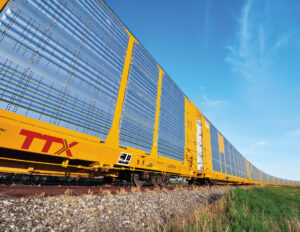Stefan Soloviev, a visionary leader with a deep-rooted passion for agriculture, is redefining the American supply chain landscape by integrating his vast agricultural operations with his railroads.
With a diverse portfolio spanning over 500,000 acres of farmland and ownership of one of the largest privately owned railroads in the United States, Soloviev is uniquely positioned to transform how goods are transported across the nation.
His strategic vision not only enhances the efficiency of supply chains but also ensures sustainability and resilience in an industry facing numerous challenges.
The Foundation: A Legacy in Agriculture and Railroads
Stefan Soloviev’s journey into the world of agriculture and railroads is deeply intertwined with his family’s legacy. As the son of real estate magnate Sheldon Solow, Stefan inherited a business empire but chose a path that diverged from the urban real estate market. Instead, he focused on the rural heartland, where he saw the potential to make a significant impact.
Soloviev’s foray into agriculture began in the 1990s when he started acquiring farmland in Kansas. Over the years, he expanded his holdings across several states, including Colorado and New Mexico. His agricultural operations are diverse, producing crops such as wheat, corn, and sunflowers. Soloviev’s commitment to sustainable farming practices is evident in his efforts to minimize the environmental impact of his operations while maximizing yields.
Parallel to his agricultural endeavors, Soloviev recognized the importance of efficient transportation in the supply chain. This realization led him to invest in railroads, culminating in the ownership of the Colorado Pacific Railroad.
The railroad, which spans over 120 miles, plays a crucial role in transporting agricultural products from his farms to markets across the country. By integrating agriculture with railroads, Soloviev is not only reducing transportation costs but also ensuring the timely delivery of fresh produce to consumers.
Revolutionizing Supply Chains Through Integration
Stefan Soloviev’s strategic vision centers around the seamless integration of agriculture and railroads to revolutionize supply chains. In an era where supply chain disruptions have become increasingly common, Soloviev’s approach offers a solution that addresses multiple challenges simultaneously.
One of the key benefits of this integration is the reduction of transportation bottlenecks. By owning both the agricultural production and the means of transportation, Soloviev has greater control over the entire supply chain. This control allows for more efficient coordination between farming activities and transportation schedules, reducing delays and ensuring that products reach their destinations faster.
Moreover, Soloviev’s approach enhances the resilience of supply chains. The COVID-19 pandemic exposed the vulnerabilities of global supply chains, with disruptions leading to shortages and price spikes.
By focusing on domestic production and transportation, Soloviev’s model reduces dependence on international supply chains, making the system more resilient to external shocks. Additionally, the use of railroads, which are less affected by fuel price fluctuations compared to trucks, further contributes to the stability of the supply chain.
Sustainability is another cornerstone of Soloviev’s vision. Railroads are one of the most energy-efficient modes of transportation, emitting significantly less CO2 per ton-mile compared to trucks.
By shifting more of the transportation burden to rail, Soloviev is reducing the carbon footprint of his operations, aligning with global efforts to combat climate change. His commitment to sustainable agriculture, combined with the use of eco-friendly transportation, positions him as a leader in the push for greener supply chains.
A Vision for the Future
Stefan Soloviev’s innovative approach to integrating agriculture with railroads is not just about optimizing supply chains; it’s about reshaping the future of food production and distribution. His vision addresses some of the most pressing challenges of our time, including sustainability, resilience, and efficiency.
Looking ahead, Soloviev’s model could serve as a blueprint for other agricultural producers and transportation companies. As the world grapples with the need to feed a growing population sustainably, Soloviev’s approach offers a viable solution that balances economic viability with environmental responsibility.
In conclusion, Stefan Soloviev’s strategic vision of integrating agriculture with railroads is a game-changer for the American supply chain. By leveraging his unique position as both a farmer and a railroad owner, Soloviev is not only transforming his operations but also paving the way for a more efficient, resilient, and sustainable future.



